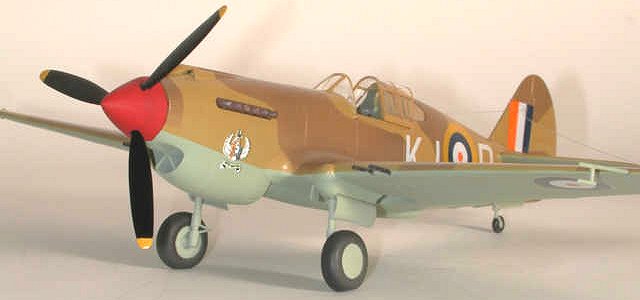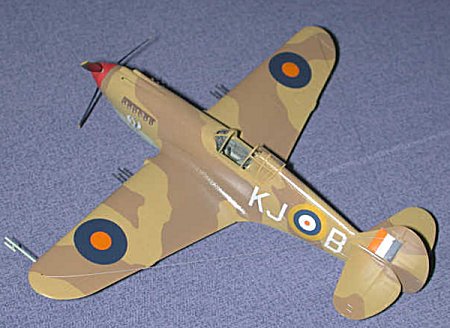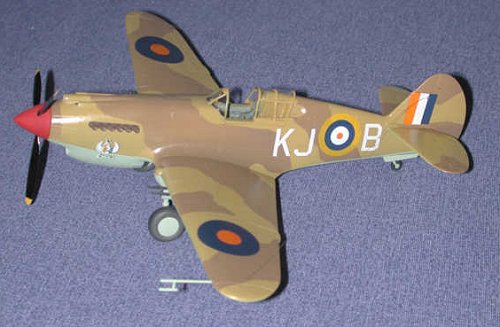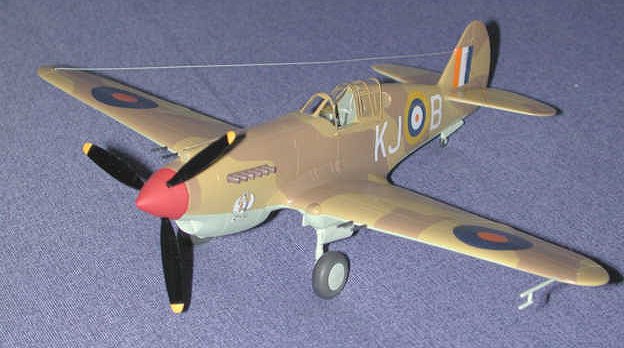
|
KIT # |
1451 |
|
PRICE: |
$15.98 MSRP |
|
DECALS: |
See Review |
|
REVIEWER: |
Sinuhe Hahn |
|
NOTES: |
Also boxed by Academy at a higher price |

|
HISTORY |
Having flown a gamut of aircraft in the Abyssinian campaign, including Hawker Furies, Gladiators, Curtiss Hawks and a select few early Mk 1 Hurricanes, the SAAF on entering the desert war was in dire need of some modern equipment with which it could tackle the mighty Luftwaffe on more even terms.
No 2 squadron “Flying Cheetahs” was the first SAAF Squadron to receive P-40 Tomahawks in July 1941 and was soon joined by 4 Sqn in November 1941. The acquisition of Tomahawks by 5 squadron occurred during March of 1942. Of interest, is that No 40 tactical reconnaissance squadron used a few P-40 Tomahawks to escort their ageing recce equipped Mk.1 Hurricanes.
 Initially the Tomahawks were delivered in US equivalents of
the RAF dark earth, dark green and sky scheme. This was replaced by the
standard desert camouflage scheme of azure blue, mid stone and dark earth.
Initially the Tomahawks were delivered in US equivalents of
the RAF dark earth, dark green and sky scheme. This was replaced by the
standard desert camouflage scheme of azure blue, mid stone and dark earth.
The aircraft we have chosen to portray appears to be in the midst of such an change, as it already features dark earth and mid stone upper surface pattern, but has still retained the Sky lower surfaces. At this stage of service, several 4 squadron aircraft displayed an attractive winged Springbok squadron badge on the cowling with the motto “We’ve Had You”. Two further squadron badges appear to have been used by 4 squadron at this time. One was decorated with an eagle crest and the Afrikaans motto “Nader die Pale Toe”, a phrase from rugby football which translates as “Closer to the Goal Posts”, while the other depicted an eagle destroying a German aircraft and the Afrikaans motto “ Vir Vryheid en Reg”, translated as “For Freedom and Justice”.
The Tomahawk acquitted itself well in the hands of SAAF pilots and they accounted for a number of enemy aircaft. Indeed in an encounter with 1/JG27, then under the guidance of “The Star of Africa” Hans Joachim Marseille, one 4 Squadron managed crash land close to base despite a very severe mauling. The fact that this badly damaged plane still made it back to base impressed the SAAF personnel to such an extent that photos of the aircraft were sent to the manufacturer in the US congratulating them on the sturdiness of their aircraft. During 1942 the Tomahawks were phased out to be replaced by the more powerful Kittyhawk Mk1 (P-40E).
|
THE KIT |
The kit chosen chosen was the Academy / Hobbycraft P-40B, due to its current availability. The Monogram version has been reported to be more accurate, but is currently hard to find locally. My overally impression of this kit was good, and even though it may not be 100% accurate everywhere, it looks the part when completed. The engraved panels are very fine and the plastic is of a very good quality.
|
CONSTRUCTION |
 The fit is in general very good. In my opinion it is one of
the better offerings to come from the Hobbycraft stable. Assembly was straight
forward, although a bit of work (fitting and sanding) was needed to fit the wing
cleanly to the fuselage. This was, however, far less than difficult than in the
case of the Mauve P-40M/N offering. The only other problem area in the Academy
kit was the attachment of the lower part of the cowling. A piece of plastic card
was used here to close the gaping hole at the back of the radiator. As the
exhausts are rather lousy, these were drilled out to improve their visual
appeal. The same procedure was applied to the wing and nose guns.
The fit is in general very good. In my opinion it is one of
the better offerings to come from the Hobbycraft stable. Assembly was straight
forward, although a bit of work (fitting and sanding) was needed to fit the wing
cleanly to the fuselage. This was, however, far less than difficult than in the
case of the Mauve P-40M/N offering. The only other problem area in the Academy
kit was the attachment of the lower part of the cowling. A piece of plastic card
was used here to close the gaping hole at the back of the radiator. As the
exhausts are rather lousy, these were drilled out to improve their visual
appeal. The same procedure was applied to the wing and nose guns.
|
CAMO & MARKINGS |
Tamiya Sky was used of for the underside colour. Gunze acrylics were used for the dark and mid stone colours. These paints are simply wonderful, and I wish I could achieve the same results from Tamiya paints. Tamiya tape was used for the masking. The tires (which are supplied in flattened form in the kit) were sprayed in Gunze Flat Tire Black. A few coats of Future (imported from the US: thank you Vivian) were applied to the model prior to application of the decals.
 The unique markings
were generated using Corel Draw and
printed using an ALPS MD 2300 printer. Although this low key ALPS printer is not
meant to print white, this can be very easily achieved by removing the ID tag
from a black cassette, applying it to white one, and printing everything as if
it were black. This does, however, mean that white backing masks had to be made
for the artwork. The roundels were from a recently released Tally Ho sheet.
Although this sheet is beautifully printed, the decals are fairly translucent
and very fragile, and care has to be exercised when using it. All markings were
dipped in a drop of Future prior to application. Once dry the model was given a
few more brief coast to seal the decals. I have not yet gotten into the habit of
weathering my models again; patience, we’ll get there.
The unique markings
were generated using Corel Draw and
printed using an ALPS MD 2300 printer. Although this low key ALPS printer is not
meant to print white, this can be very easily achieved by removing the ID tag
from a black cassette, applying it to white one, and printing everything as if
it were black. This does, however, mean that white backing masks had to be made
for the artwork. The roundels were from a recently released Tally Ho sheet.
Although this sheet is beautifully printed, the decals are fairly translucent
and very fragile, and care has to be exercised when using it. All markings were
dipped in a drop of Future prior to application. Once dry the model was given a
few more brief coast to seal the decals. I have not yet gotten into the habit of
weathering my models again; patience, we’ll get there.
|
CONCLUSIONS |
This has been a fun build and completed very rapidly, without having to resort to tons of putty and meters of sandpaper, and makes a nice addition to my SAAF collection.
Copyright ModelingMadness.com. All rights reserved. No reproduction in part or in whole without express permission from the editor.
If you would like your product reviewed fairly and fairly quickly, please contact the editor or see other details in the Note to Contributors.
Back to Reviews Page 2024